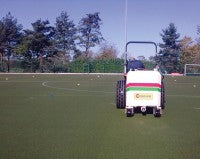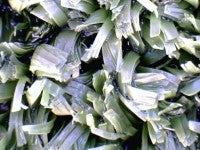Mild weather leads to worst algal blooms ever seen on artificial surfaces
 From short pile tennis courts through to water based and sand dressed or filled pitches, the result is the same; everything was going fine then, one morning, the surface starts showing signs of sludge across the surface.
From short pile tennis courts through to water based and sand dressed or filled pitches, the result is the same; everything was going fine then, one morning, the surface starts showing signs of sludge across the surface.
Simplified, the typical drainage scenario on a sand based pitch is as follows; for several years everything appears fine, and drainage is good. Suddenly, the drainage rates slow down and then, after a further year or so, the drainage fails. Water can't percolate through the surface as it should; the organic contamination in the pitch floats to the surface, water then drains slowly through the lowest spots on the surface, leaving the sludge behind as dark coloured puddles.
Usually, with either a visual assessment or sedimentation testing, it is possible to determine what stage these surfaces are at in their lifespan, in respect of drainage and sedimentation. However, algae nullifies everything. Really rapid blooms can lead to temporary drainage failures, and this has the same result as a conventional drainage failure. Water cannot drain through the surface, even relatively small percentages of contamination can be flushed to the surface and leave the dreaded sludge puddles.
This autumn, I have seen blocks of tennis courts and parts of pitches completely covered with brown algae. So, what's the solution? Answers on a post card please!
 We have ongoing trials with numerous chemicals but, at the moment, obtaining consistent results from these is proving impossible, so what chance in the real world.
We have ongoing trials with numerous chemicals but, at the moment, obtaining consistent results from these is proving impossible, so what chance in the real world.
You can remove the sludge from the surface, but as with conventional drainage failures, as soon as it rains again it's back! You can spray it with any one of the dozen or so chemicals available, keep your fingers and everything else crossed and hope that you have good results!
The other reason that algae is so bad this year is that, after two cold winters, problems did not manifest themselves until this year.
I am just wondering whether the Eskimos have a frost dance, something similar to a rain dance, I would quite happily take the next plane to the north pole to learn the steps and chants that are needed to induce a couple of hard frosts, because a couple of them will kill the stuff off and return everything to normal.
So, by the time you read this, if winter has arrived with a vengeance, please don't blame it on the middle aged man you saw on the news, performing a strange ritual on his local tennis courts, clad only in a seal skin, wearing a silly fur hat, brandishing a whale bone and chanting mumbo jumbo.
Moss and algae infestation can be a serious problem on all types of outdoor sports and amenity surfaces.
Failure to treat the algae and moss quickly can eventually mean that only a full refurbishment of the surface will restore the pitch.
Early treatment is essential with a safe and effective moss or algae killer

Moss usually has two growth periods during a year, the first in the autumn, after which the plant produces spores during the winter ready to germinate in the following spring. The second in the spring, when the plant produces spores again ready to germinate in the autumn, thus continuing the life cycle.
Algae is also a serious and potentially hazardous problem on artificial surfaces, particularly water based hockey pitches, as it can severely impede drainage, especially under the present UK weather conditions. If you can see moss on the surface of your court or pitch, you probably already have a significant algal infestation, as the two thrive in the same conditions.
Three easy to spot indicators of the presence of algae on your surface are:
1) a slippery surface
2) dark patches that vary in size
3) a players clean white kit becoming extremely dirty during a game, especially if they fall over
Algae should be treated promptly because of the potentially hazardous conditions it can create for users of the surface.
Try to prevent the moist conditions that favour the establishment of moss and algae by maintaining good surface water infiltration and drainage. Unfortunately, the moist conditions cannot be avoided on a water-based pitch.
Inspect the surface for moss or algae on a regular basis, and treat any outbreaks of moss or algae as and when required.
Treatment:
To treat an infected area effectively, it must be sprayed with a proprietary brand of Moss & Algae control. This can be applied using tractor mounted sprayers, walkovers and knapsacks at most times of the year, providing conditions are moist.
Spot treatments should be carried out as and when required during the rest of the year.
Water based pitches may require several treatments per year, with the addition of regular deep cleaning, owing to the ideal conditions for moss and algal growth that water based surfaces provide.
www.sweepfast.com
